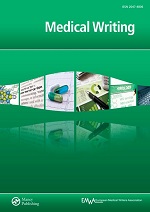
Abstract
Patient education that overcomes literacy barriers supports quality care. This article provides an overview of health literacy, describes the concepts of readability and accessibility, and discusses how to empathise with the patient's experience and ask interactive questions. The tips in this article are based on a learner-centred approach and 20 years of publishing X-Plain® patient education tutorials. This information should help health content writers facilitate patient comprehension, improve health outcomes, and achieve care goals set by healthcare providers.
 Download the full article
Download the full article
References
- Ad Hoc Committee on Health Literacy for the Council on Scientific Affairs. Report on the Council of Scientific Affairs. Chicago, IL, US: American Medical Association; 1999.
- U. S. Department of Education, National Institute of Literacy. Illiteracy Statistics. 2015 [cited 2 Sep 2105]. Available from: http://www.statisticbrain.com/number-of-american-adults-who-cant-read/
- Vernon JA, Trujillo A, Rosenbaum S, DeBuono B. Low Health Literacy: Implications for National Health Policy. Washington, DC: The George Washington University Center for Health Policy Research; 2003.
- Houts PS, Doak CC, Doak LG, Loscalzo MJ. The role of pictures in improving health communication: a review of research on attention, comprehension, recall, and adherence. Patient EducCouns 2006;61:173–90.
- Bialik C. Do Readability Formulas Work? The Numbers. The Wall Street Journal. 2008 Mar 13. Available from: http://blogs.wsj.com/numbers/do-readability-formulas-work-297/
- Ylvisaker M, Hibbard M, Feeney T. What Is an Advance Organizer? Albany, NY: Brain Injury Association of New York State; 2006 [cited 2 Sep 2015]. Available from: http://www.projectlearnet.org/tutorials/advance_organizers.html
- Doak LG, Conrath C, Root JH. Teaching Patients with Low Literacy Skills. 2nd ed. Philadelphia: J. B. Lippincott; 1996.
- Centers for Disease Control and Prevention (CDC). Simply Put: A Guide for Creating Easy-to-Understand Materials, 3rd ed. Atlanta, GA: Centers for Disease Control and Prevention; 2009. Available from: http://www.cdc.gov/healthliteracy/pdf/Simply_Put.pdf
- Richards S. Ampersands, Date Ranges and Contractions: Style Guidance; 2014 [cited 2 Sep 2015]. Available from: https://insidegovuk.blog.gov.uk/2014/02/25/ampersands-date-ranges-and-contractions-style-guidance-2/
- Cornett S. Assessing and Addressing Health Literacy. OJIN: The Online Journal of Issues in Nursing, 2009;14:3.
- Adams RJ. Improving health outcomes with better patient understanding and education. Risk Manag Healthc Policy. 2010;3:61–72.
- Klein DW, Simon CM, Schartz HA. Interactive multimedia consent for biobanking: a randomized trial. Genet Med. 2015; Apr 2.
- Davis TC, Berkel HJ, Holcombe RF. Informed consent for clinical trials: a comparative study of standard versus simplified forms. 2015. J Natl Cancer Inst. 1998;90:668–74.
- Centers for Disease Control and Prevention (CDC). Communicating with and about People with Disabilities. Atlanta, HA: Centers for Disease Control and Prevention. 2013. Available from: http://www.cdc.gov/ncbddd/disabilityandhealth/pdf/disabilityposter_photos.pdf
- Strong T. Developmental Disabilities Nurse Certification Review: A Multiple Choice Practice Method from the Knowledge Testing Review Series; 2014.
- Na tional Association of the Deaf. Frequently Asked Questions. Question – What is the difference between a person who is ‘deaf,’ ‘Deaf,’ or ‘hard of hearing’? [cited 2 Sep 2015] Available from: http://nad.org/issues/american-sign-language/community-and-culture-faq
- Clark RC, Mayer RE. E-Learning and the Science of Instruction: Proven Guidelines for Consumers and Designers of Multimedia Learning. San Francisco, CA: Jossey-Bass/Pfeiffer; 2003.
- Malamed C. Realistic Graphics and Learning: What's Most Effective? 2010 [cited 2 Sep 2015]. Available from: http://theelearningcoach.com/media/graphics/realistic-graphics-and-learning/
- Hoots PS, Doak CC, Doak LG, Loscalzo MJ. The role of pictures in improving health communication: a review of research on attention, comprehension, recall, and adherence. Patient Educ Couns. 2006;61(2):173–90.
- Wike K. Hospitals ‘Wired’ For Patient Engagement, Data Security. Health IT Outcomes. 24 July 2015. Available from: http://www.healthitoutcomes.com/doc/hospitals-wired-for-patient-engagement-data-security-0001
Search
Articles
Links
Editoral Board
Editor-in-Chief
Co-Editors
Managing Editor
Victoria White
Deputy Managing Editor
Alicia Brooks Waltman
Associate Editors
Section Editors
AI/Automation
Biotechnology
Digital Communication
EMWA News
Freelancing
Gained in Translation
Getting Your Foot in the Door
Good Writing Practice
Pablo Izquierdo / Alison McIntosh
In the Bookstores
Publications
Medical Communications/Writing for Patients
Medical Devices
My First Medical Writing
News from the EMA
Pharmacovigilance
Regulatory Matters
Regulatory Public Disclosure
Louisa Ludwig-Begall / Sarah Kabani
The Crofter: Sustainable Communications
Veterinary Writing
Editors Emeritus
Layout Designer
Chris Monk
 Visit the EMWA website
Visit the EMWA website